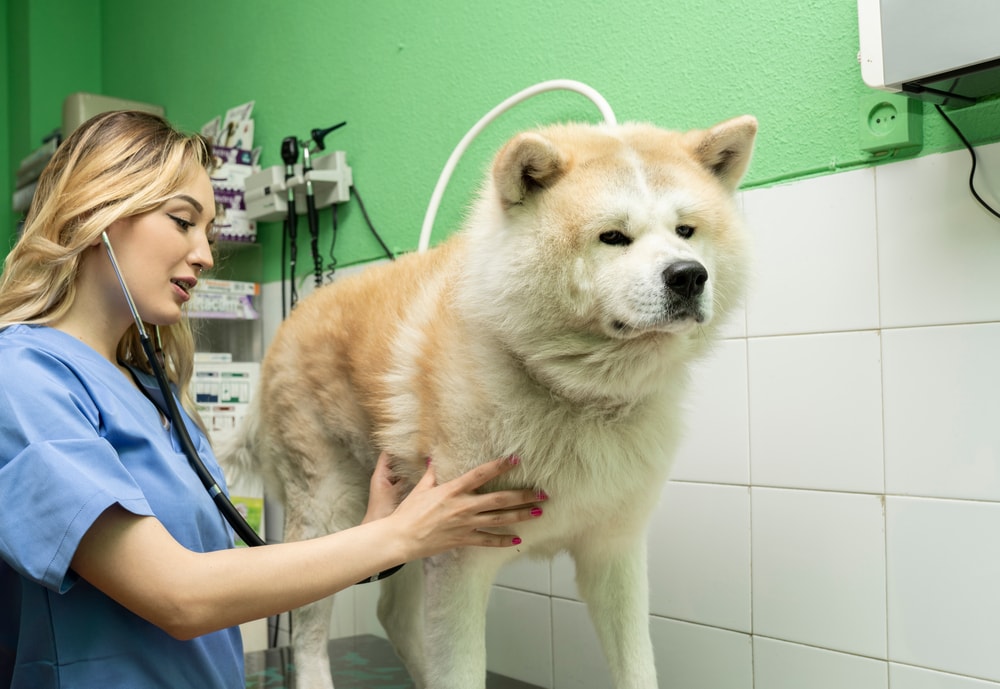Pancreatitis in Dogs: Our Vet Explains the Signs, Causes & Life Expectancy
By Dr. Leigh Wilder, DVM (Vet)
Updated on

Click to Skip Ahead
When your canine companion is under the weather, it may leave you feeling worried and stressed. What could be going on, and how can you help them to feel better? If your dog receives a diagnosis of pancreatitis from your veterinarian, precisely what does this mean for your pet? And how concerned should you be?
We’ll discuss canine pancreatitis, including its signs, causes, diagnosis, treatment options, and prognosis, giving you the most accurate information to help you support your pet and work toward recovery from this serious condition.
What Is Pancreatitis?
Pancreatitis is an inflammatory condition affecting the pancreas, an important abdominal organ that lies underneath the stomach and along the duodenum (the first section of the small intestine). In a healthy dog, the pancreas has two main jobs: secreting digestive enzymes that help break down the food they eat and secreting hormones that help regulate how their body uses nutrients.
The digestive enzymes from the pancreas remain inactivated until they travel through the pancreatic duct and reach the duodenum, where they activate to begin assisting with digestion. In dogs with pancreatitis, however, these digestive enzymes are activated prematurely within the pancreas and begin to digest the pancreas itself—leading to inflammation and tissue damage, which may also affect the nearby liver. Pancreatitis may either be acute (sudden onset) or chronic.

Signs of Pancreatitis
Signs of pancreatitis in dogs can range from mild to severe. Mild cases of pancreatitis may show minimal, if any, signs, while more serious cases typically present with a combination of the following clinical signs:
- Loss of appetite
- Vomiting
- Weakness
- Diarrhea
- Dehydration
- Lethargy
- Abdominal Pain
While many of these signs are easy to identify, abdominal pain in dogs may be more difficult to recognize. A dog demonstrating a “praying position,” in which their back legs are raised and their front legs and chest are held close to the floor, may be signaling that they are experiencing abdominal pain.
What Causes Pancreatitis?
The majority of canine pancreatitis cases are idiopathic, meaning that no specific cause is identified. Dogs of any age can develop pancreatitis, although the disease is more commonly seen in dogs greater than 5 years of age. Potential risk factors for the development of canine pancreatitis are diverse and include the following:
- Breed Predisposition: Terriers, Poodles, Cavalier King Charles Spaniels, and Miniature Schnauzers have been identified as breeds at a higher risk for developing pancreatitis.
- Adverse Drug Reactions: While many medications have been implicated in causing pancreatitis in humans, few cases have been confirmed in animals. However, certain medications, such as azathioprine, potassium bromide, phenobarbital, and L-asparaginase, may be considered potential causes of pancreatitis.
- Dietary Factors: Canines fed low-protein and high-fat diets may be at a higher risk of developing pancreatitis. Dogs that “dumpster dive” or get into the garbage, or those that ingest a sudden high-fat meal may also be prone to episodes of acute pancreatitis.
- Trauma: Blunt force trauma, such as that sustained from being hit by a car, may result in inflammation and subsequent pancreatitis.
- Hormonal Imbalance: Conditions such as diabetes mellitus and hypothyroidism may predispose dogs to develop pancreatitis based on altered fat metabolism. Hypercalcemia (an elevated blood calcium level) also increases pancreatitis risk, as it activates stored digestive enzymes.
- Body Condition: Obese dogs are at a higher risk of developing pancreatitis than their lean counterparts.
- Infectious Disease: Babesiosis and leishmaniasis are parasitic infections that have been reported to cause canine pancreatitis.
While certainly an undesirable situation, dogs suffering from stress or anxiety have not been noted to be at higher risk for the development of pancreatitis.
How Is Pancreatitis Diagnosed?
If your dog has an episode of vomiting but otherwise seems normal, it may be appropriate to monitor the situation. However, if multiple episodes of vomiting are noted or if vomiting occurs with any of the other signs noted above, a visit to the veterinarian is recommended. Your veterinarian will begin by taking a thorough history of your dog’s signs. They may also ask questions regarding any health conditions, current medications or supplements, changes in diet, or things your pet may have gotten into. Based on your dog’s history and exam findings, your veterinarian may recommend further evaluation with the following tests:
- Complete Blood Count (CBC)
- Serum biochemistry profile
- Abdominal x-rays
- Abdominal ultrasound
- SNAP cPL or Spec cPL
The SNAP cPL (canine pancreas-specific lipase) and Spec cPL are tests that measure pancreatic lipase concentration in the blood; they are considered the most specific diagnostic test for canine pancreatitis. A SNAP cPL can be performed quickly by your veterinarian in-clinic to rule out pancreatitis as a cause for your dog’s signs, while a Spec cPL requires sending a blood sample to a reference laboratory. The information obtained from a CBC, biochemistry profile, x-rays, or ultrasound may help support a diagnosis of pancreatitis or rule out other diseases; it is often considered together with the results of the SNAP cPL or Spec cPL when diagnosing pancreatitis.

Treatment for Pancreatitis
Specific treatment for pancreatitis will depend on the severity of your dog’s clinical signs and whether any underlying conditions predisposing them to pancreatitis have been identified. In general, supportive care for canine pancreatitis may include:
- Fluid Therapy: Dogs with pancreatitis are often dehydrated due to vomiting and diarrhea, and benefit from rehydration with either intravenous (IV) or subcutaneous fluids. Fluids are important as they help replenish blood volume and improve circulation to the pancreas.
- Pain Medication: Pancreatitis is a painful condition, and a variety of pain medications may be used by your veterinarian to keep your dog comfortable throughout their treatment.
- Antiemetic Medication: Pancreatitis commonly causes vomiting and inappetence due to nausea; antiemetic medications are used frequently for the management of these symptoms.
- Nutritional Management: Dogs with mild signs of pancreatitis may be offered a low-fat diet; veterinary prescription diets are often used for this purpose. In dogs that are unwilling to eat, feeding tubes (such as those placed through the nose and extending to either the esophagus or stomach) may be considered to provide more consistent nutrition.
- Gastric Acid Suppression: Medications designed to reduce acidity within the stomach may be recommended by your veterinarian to minimize the risk of stomach ulcers or esophageal inflammation.
Pancreatitis Prognosis
The prognosis for dogs with pancreatitis is variable, and the initial assessment of the severity of the condition may be challenging. Dogs with mild symptoms that are eating on their own may recover with outpatient supportive care such as a low-fat diet and oral medications—these dogs tend to have a good prognosis. Dogs with severe pancreatitis, however, tend to have a poor prognosis and may pass away even with hospitalization and aggressive treatment.
Dogs that experience multiple episodes of acute pancreatitis, and subsequent pancreatic tissue damage, may be at an increased risk for complications. These include the development of chronic pancreatitis, diabetes mellitus, and exocrine pancreatic insufficiency (EPI). While treatable, the management of these conditions may be lifelong.

Conclusion
In summary, canine pancreatitis is a common, yet serious medical condition that can present with a wide range of symptoms. If your dog receives a diagnosis of pancreatitis, partnering with your veterinarian to provide supportive care tailored to their specific needs will provide the best opportunity to overcome this difficult disease.
Featured Image Credit: Dragon Images, Shutterstock












